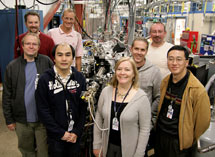
Handy Links
SLAC News Center
SLAC Today
- Subscribe
- Archives: Feb 2006-May 20, 2011
- Archives: May 23, 2011 and later
- Submit Feedback or Story Ideas
- About SLAC Today
SLAC News
Lab News
- Interactions
- Lightsources.org
- ILC NewsLine
- Int'l Science Grid This Week
- Fermilab Today
- Berkeley Lab News
- @brookhaven TODAY
- DOE Pulse
- CERN Courier
- DESY inForm
- US / LHC
SLAC Links
- Emergency
- Safety
- Policy Repository
- Site Entry Form

- Site Maps
- M & O Review
- Computing Status & Calendar
- SLAC Colloquium
- SLACspeak
- SLACspace
- SLAC Logo
- Café Menu
- Flea Market
- Web E-mail
- Marguerite Shuttle
- Discount Commuter Passes
-
Award Reporting Form
- SPIRES
- SciDoc
- Activity Groups
- Library
Stanford
Around the Bay
People: SSRL's New CAMS Group Has Great Chemistry
The Stanford Synchrotron Radiation Lightsource at SLAC is an invaluable resource for researchers studying everything from the ebola virus to carbon nanotubes. Scientists from all over the world compete to bring their research here, and the SSRL's bright X-rays aren't the only reason.
"The people at SSRL really make it stand out from other facilities," said Pierre Kennepohl, a University of British Columbia chemist studying sulfur oxidation at Beamline 4-3.
That may be because SSRL's staff scientists have an unusual amount of independence; they spend only half their time helping users launch and maintain experiments in the beamlines. The other half is dedicated to pursuing their own research topics, which vary as widely as the specialties of the visiting users. "The biggest thing is that they understand not just what you're trying to do, but why you're trying to do it," Kennepohl said. "It really does make a difference when you're working with people who do their own research."
As accomplished researchers in their own right, SSRL's staff scientists can offer help beyond instrumentation improvements.
"Besides fixing technical problems occurring during the operation of the beamline, we like to offer the users scientific support," said staff scientist Stefan Mannsfeld, who studies organic semiconductors within the SSRL's new Chemical and Materials Science & User Support Group, or CAMS. "As users describe what they want to find out, I can try to steer them in the most promising direction."
CAMS was formed in February to unite SSRL staff scientists who study the physical properties of materials: how they form and break, why they are magnetic, and their electronic, structural and chemical characteristics. CAMS works in parallel with the Structural Molecular Biology & Molecular and Environmental & Interface Science Research & User Support Department, SSRL staff scientists who study the structure and function of proteins and other biomaterials, and environmentally important systems. The two staff scientist groups work closely with beamline engineers and scientists, electronics engineers, technicians and computer experts to provide user support at SSRL.
CAMS head Uwe Bergmann said that making CAMS its own group will add clarity to planning and budgeting processes, and help communicate the group's needs up the management chain.
"It will be great for transparency," Bergmann said. "I think the management made an excellent decision."
CAMS scientists study a wide range of research topics. Donghui Lu teases out the characteristics of iron superconductors. Hirohito Ogasawara looks at fast reactions in water. And Apurva Mehta images shards of ancient pottery. Bergmann said that as a staff scientist continues to work with users, his or her research interests and collaborations tend to flourish in new and often unexpected directions.
"When a university hires a new faculty member, they look for a person who is experienced in one topic. That person might try to apply every technique to studying that one system," Bergmann said. "Here, a scientist is connected to a set of techniques, but the types of research can be very broad."
Bergmann, who was recruited to SLAC to develop advanced X-ray spectroscopy techniques, modified an imaging technique called X-ray fluorescence in order to reveal obscured pages of a thousand-year-old Archimedes manuscript. The new "rapid scan" technique now has a growing number of users looking at everything from brains to fossils. Bergmann said that the beam time allotted to staff scientists testing the waters of unusual projects helps expand SSRL's research areas.
"I did the first run of Archimedes on staff priority beam time," he said. "It's a great way to explore new little projects within the scope of the research done by the Department of Energy and Stanford."
As committed researchers, CAMS scientists are also sometimes users at other synchrotron facilities, where they may discover new instrumentation and techniques that they can bring back to SSRL.
"You learn something new when you visit another facility," Bergmann said. "It's like cooking with other people."
"This has really served SSRL and the scientists well," said SSRL Director Joachim Stöhr of the emphasis on independent research. "We believe this is really the way to keep the best young people. In the end SSRL benefits from ideas and experience our scientists bring back from other facilities."
—Lauren Schenkman
SLAC Today, March 25, 2009
